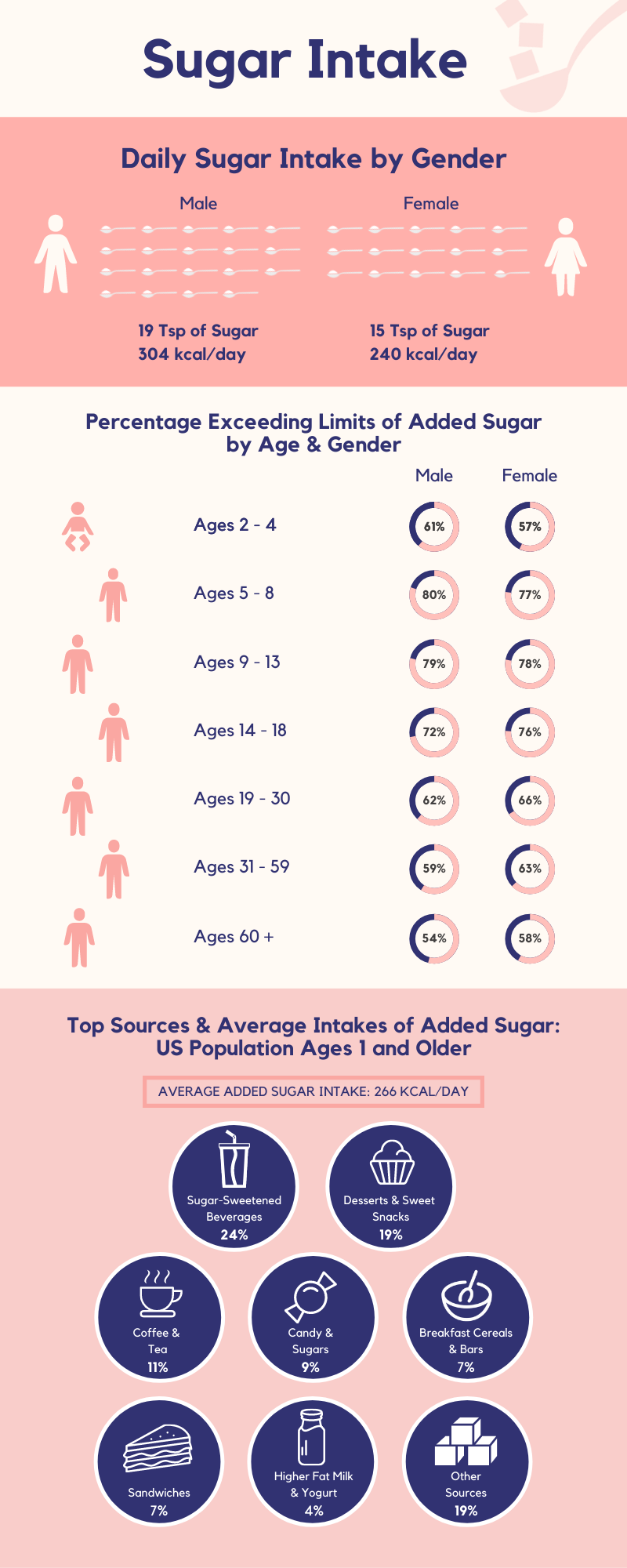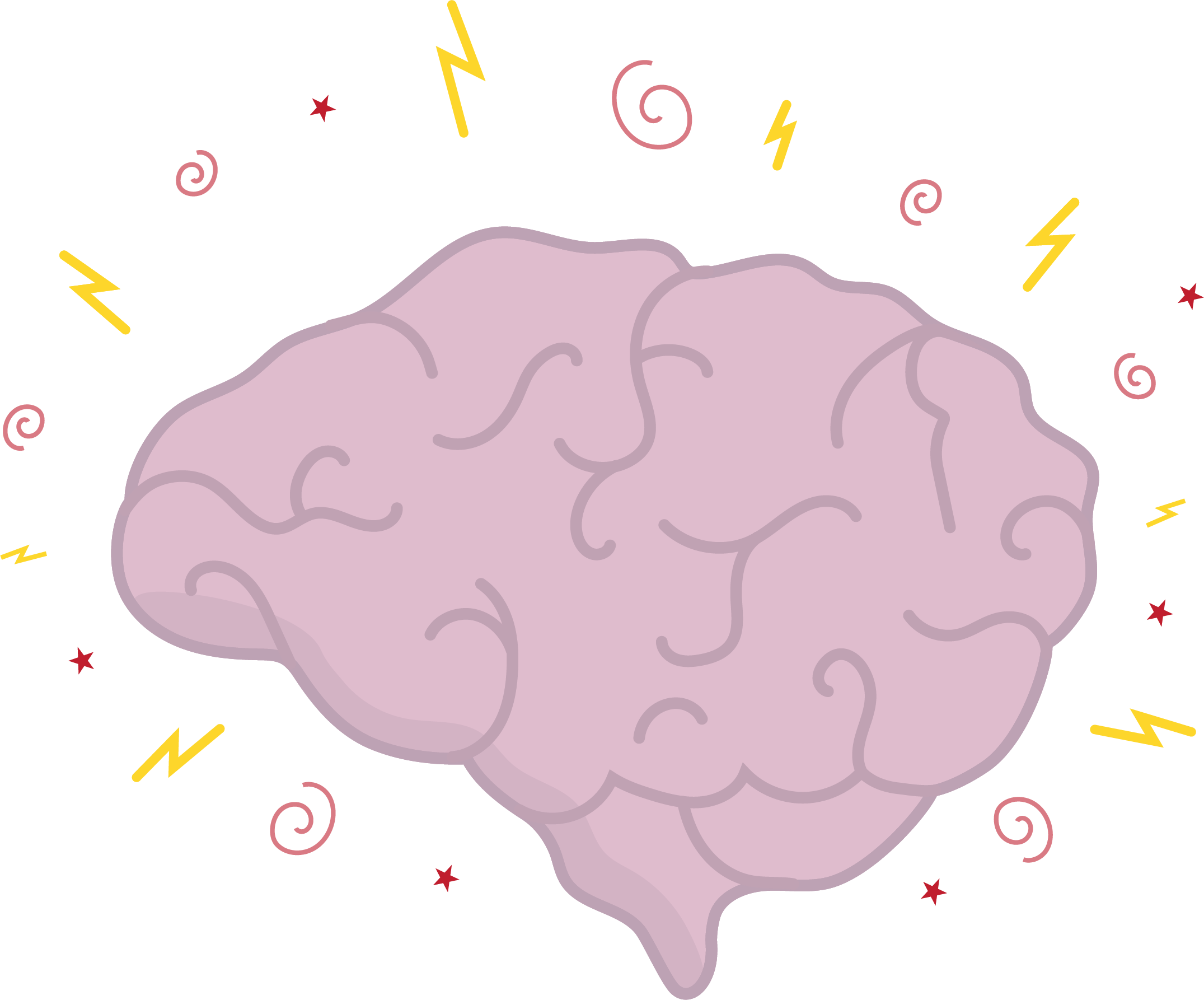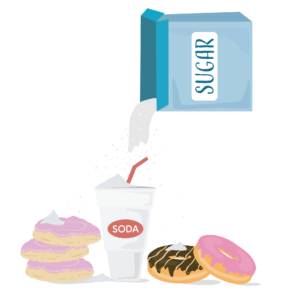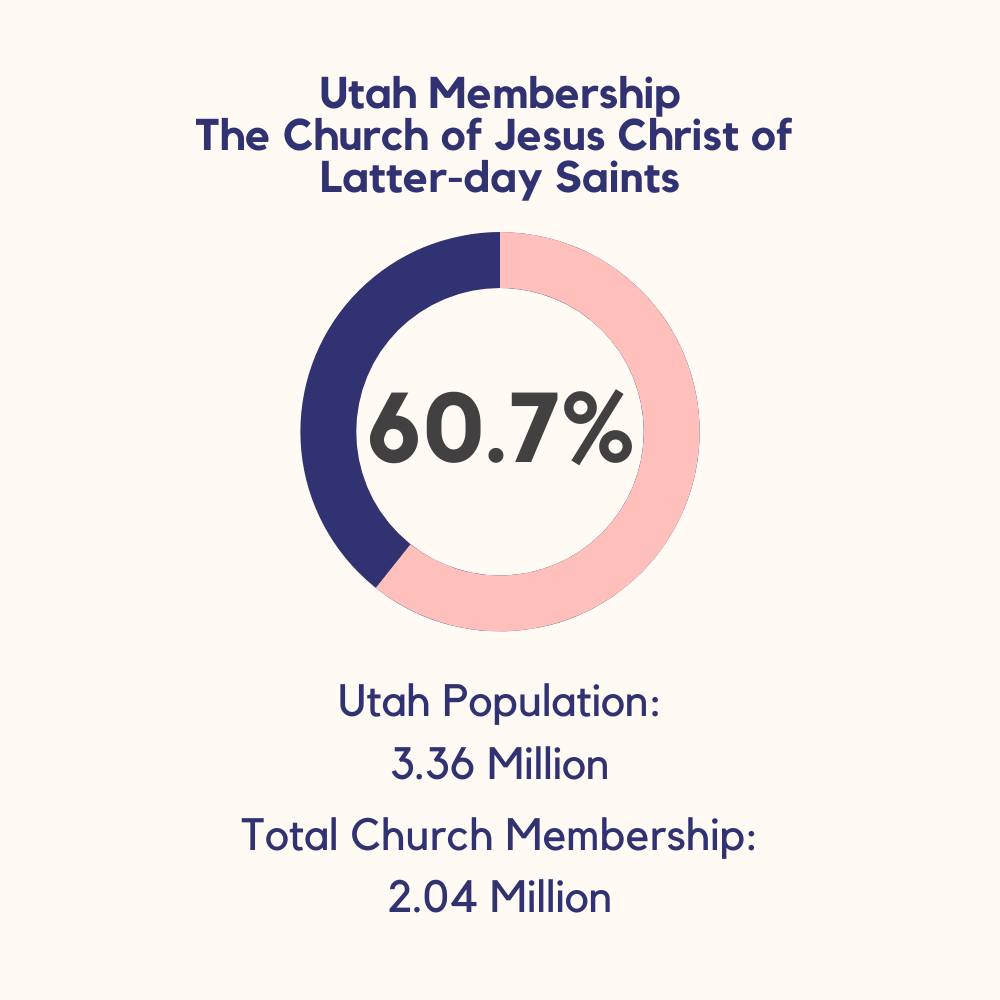The sweet smell of cookies and soda dances around the store. The door opens and eager students file into a line starting at the counter. As a customer finishes their order, they move from the counter and the line moves up. Students become more anxious with anticipation the closer they get to place their orders and satisfy their sweet craving.
The store’s door opens once again and more students shuffle up the line with one thing on their mind — sugar.
This is the everyday experience at local sweet shops around Utah. Many customers eat their sweet treats, unaware of the long-term effects of added sugar consumption and the culture built around sugar.
Sugar and its effects
According to the CDC, sugars and syrups added to foods and beverages during processing are known as “added sugars.” The organization’s list for added sugars includes “brown sugar, cane juice, corn syrup, dextrose, fructose, fruit nectars, glucose, high-fructose corn syrup, honey, lactose, malt syrup, maltose, maple syrup, molasses, raw sugar and sucrose.” These added sugars contribute solely to caloric intake in one’s diet and do not add essential nutrients, the CDC says.
In 2020, the United States Department of Agriculture published a Dietary Guidelines for Americans with suggestions for what consumers should eat to stay healthy. One of these suggestions includes reducing sugar intake. The guideline recommends no more than 10% of one’s daily caloric intake come from added sugar. This limit should allow for flexibility while still meeting food group recommendations.
However, the data shows Americans are consuming 13% of their daily caloric intake from added sugar, accounting for an average of almost 270 calories per day.
Enlarge

Long-term overconsumption of added sugar can have grave effects on the body, decreasing one’s quality of life.
BYU food science professor Gene Ahlborn said the main nutrient the brain consumes is glucose, an added sugar.
“You need sugar to have proper neurological functions. Too much sugar, though, can actually have a negative impact on our brains neurologically,” Ahlborn said.
He said sugars like fructose and glucose affect the brain’s dopamine levels. Dopamine is a feel-good neurotransmitter. Issues with dopamine levels are associated with drug addictions, diseases and other neurological dysfunctions.
He said an increase in dopamine levels can affect a person’s behavior, learning and memory. Ahlborn warned about the negative impacts of the sugar consumption cycle — consuming sugar, feeling good, crashing then craving more. To stabilize brain and bodily function, sugar should be consumed in moderation.
Is sugar addiction real?
Enlarge

Although this cycle of sugar consumption is similar to the addiction cycle for drugs and other substances, sugar addiction is still being researched and results are inconclusive.
Research published in the European Journal of Nutrition in 2016 said there is a lack of evidence to support sugar addiction in humans.
The study said, “We find little evidence to support sugar addiction in humans and findings from the animal literature suggest that addiction-like behaviors, such as binging, occur only in the context of intermittent access to sugar. These behaviors likely arise from intermittent access to sweet tasting or highly palatable foods, not the neurochemical effects of sugar.”
The study suggested labeling sugar addiction as a primary cause of weight gain is an oversimplification and ignores the complexities of eating disorders and obesity.
BYU nutritional science professor James LeCheminant gave further insight into sugar addiction and its effects on the brain. LeCheminant earned his doctorate in exercise science, physical activities and weight management from the University of Kansas.
“The brain is set up to perceive foods with sugar as things that taste good; they provide a reward and should be repeated,” LeCheminant said.
However, he said he is unsure if this constitutes a reasonable cause to label the overconsumption of sugar as an addiction. LeCheminant said the reason people are drawn to sugar might be because it is used as comfort food.

Sugar-filled treats make up a large percentage of sugar intake in American diets. (Made in Adobe Illustrator by Andrew Nieves)
Sugar’s effects on the body continue to be a controversial topic. While research says there is no causal link between sugar and diseases, some doctors have said otherwise.
Research published in a journal by the Multidisciplinary Digital Publishing Institute in 2016 concluded there was very little evidence to support that sugar increases risk factors for diseases such as diabetes, high blood pressure or cardiovascular disease.
“Singling out added sugars as major or unique culprits for metabolically based diseases such as obesity, diabetes and cardiovascular disease appears inconsistent with modern high quality evidence and is very unlikely to yield health benefits,” the study said.
In contrast, LeCheminant said there is a link between too much fructose in the body and non-alcoholic fatty liver disease. This disease occurs when excess fat builds up in the liver and LeCheminant said this disease has become more prevalent in the past 50 years.
“People have liver issues because we’ve always consumed too much alcohol, but the non-alcoholic fatty liver disease has risen quite a bit,” LeCheminant said.
Evidence in an article published in the Journal of Hepatology in 2018 linked the rising prevalence of this disease with the rise in obesity and diabetes rates.
“Recent evidence suggests that diets high in sugar from sucrose and/or high fructose corn syrup not only increases the risk for non-alcoholic fatty liver disease, but also, nonalcoholic steatohepatitis,” the study said.
This research says cutting out sugary beverages and overall fructose intake, especially from added sugars, may have a considerable impact on reducing hepatic fat buildup.
Dental health
An article published by the Dental Clinics of North America in 2019 said they found a positive and statistically significant association between added sugar intake and dental caries in a study conducted on children ages 18 years and younger. The study defines dental caries as “the number of decayed, missing or filled primary and permanent tooth surfaces as a proportion of the total number of tooth surfaces in the mouth.”
This research identifies sugar-sweetened drinks as the major cause of dental caries in children in the U.S. and recommends policy changes like local beverage taxes to improve health.
“Dental health professionals are in a position to implement clinical strategies that can help to reduce added sugar intake in patients and should advocate for broader policy-based solutions,” the study said. “Local beverage taxes are effective and are part of the solution. Sugar-sweetened beverage taxes reduce intake and may also prevent chronic diseases like obesity.”
Dr. Wyatt Humes, Dean of the School of Dentistry at the University of Utah, related similar experiences in his practice. He said tooth decay has become increasingly worse since his practice in the 1970s. He said this occurred because families began buying more pre-prepared and industrial food containing more sugar.
“There's an absolute correlation between diabetes rates in communities and tooth decay rates in communities, the same pattern of dietary behavior leads to diabetes.” Dr. Wyatt R. Humes
Humes said the rise of sugar in food products, as well as the frequency of sugar intake, can lead to diabetes and tooth decay.
Comparing his time as a professor and executive vice chancellor at the University of California Los Angeles to his time in Utah, Humes said there is slightly more tooth decay in Utah. He said pediatricians care greatly about this problem and want to help, but it is hard to work against advertisements and manufactured food in the supermarket.
Likewise, Humes said students come to the School of Dentistry because they see a need to help others. Humes teaches tooth decay prevention and advises people to educate themselves on ways to prevent tooth decay.
One way he suggests for people to prevent tooth decay is to cut the duration of exposure to sugar, as more exposure leads to more cavities.
“Quantity is not the issue actually, it’s frequency. A small amount frequently will be very devastating,” Humes said.
Target market: Utah

Utah is a target market for sugar companies. (Made in Adobe Illustrator by Andrew Nieves)
With an understanding of the long-term effects of the overconsumption of sugar, the role of culture comes into question.
Despite the long-term effects of consuming too much sugar, Utah culture is built around sweets. Utah is the starting point for many cookie and soda shops, some of which have crossed the state’s border and become national chains.
Swig N’ Sweets started in 2010 in St. George and expanded from Utah to other states such as Arizona and Oklahoma.
Isaac Cordy, marketing manager of Swig, said the company’s goal “goes so much further than soda. The idea is to put a smile on the customer’s face as many of our customers frequent Swig as a ‘pick-me-up!’”
He said the company’s target market is busy moms with kids, to provide a quick stop to lift them and help them to keep going with their day. Cordy said the company is still expanding to other markets and demographics.
Emily Walker, franchise marketing manager for Crumbl Cookies, said the company also had the same initial target market. Crumbl opened its first store in 2017 in Logan, Utah. Since then, the company has expanded to over 300 bakeries located in 36 states nationwide.
“We’re expanding a lot across the nation,” Walker said. “In fact, we’re trying to target a lot of different segments. But women, initially in that demographic, is who we were targeting in Utah.”
Church and dating culture
Walker believes the success of sweet shops and dessert stores near BYU has a lot to do with the culture and activities centered around The Church of Jesus Christ of Latter-day Saints.
“I feel like there are just so many treats at the end of so many activities that we really associate that with a fun social outing,” Walker said. “That’s just become kind of ingrained in us.”
Andrea Arlt, the owner of the Twisted Sugar store located in Provo, had the same response concerning Utah culture. She and her husband started the store last October and the business has seen exponential growth since then. Arlt believes the growth of soda and cookie shops is connected to the large population of members of the Church.
Enlarge

Arlt, a Church member herself, said she drinks soda every day, but typically of the diet variety.
“We don’t drink alcohol, we don’t smoke, we don’t do all those things. So we drink a lot of soda and we eat a lot of sugar,” Arlt said.
Arlt was referring to the guidelines written in the Word of Wisdom, a health code and commandment followed by members of the Church. According to the Church’s website, the revelation was given to the prophet Joseph Smith in 1833 and has since become a commandment for members to follow.
The Church’s website said since the initial revelation, there has been a rise in the world of alcohol and tobacco consumption as well as other unhealthy substances.
“The Word of Wisdom, given in its early American context, did not anticipate or specifically address many substances that have since become common. Over time, Church leaders have emphasized the underlying principles of the revelation, such as caring for the health of the body and avoiding addictive substances.” The Church of Jesus Christ of Latter-day Saints
In avoiding addictive substances, sugar has become a vice, said Blake Barkdull, co-owner of local ice cream sandwich business The Penguin Brothers.
He believes the avoidance of addictive substances has created a unique market for dessert companies, especially in Provo.

Utah culture encourages going on dates, which are often to dessert shops. (Made in Adobe Illustrator by Andrew Nieves)
Barkdull said dating also contributes to the consumption of sugar as there is a high percentage of young adults who go on dates because it is encouraged.
“We go on different dates to different places, local places, and a lot of times, dessert shops,” Barkdull said. “Food makes sense because everyone likes food, everyone likes dessert. It’s a semi-cheap, easy, relaxed date idea.”
He said he has seen couples come to the store on their first date and then return to hire the Penguin Brothers for their wedding. The business has transitioned considerably to catering events, which has become a large part of their business revenue. The high marriage rates in Utah and at BYU allow them to cater many weddings.
“Being close to BYU, we kind of get that dating culture and hopefully we get to be a fun part of their relationship and even marriage,” Barkdull said.
Sugar balance
To create a healthy relationship with sugar, LeCheminant said people must be intentional with their food. This includes planning ahead, keeping track of food consumed and being aware of how one feels afterward, not only physically, but also mentally and emotionally.
“I think this level of individualization and awareness can really help a person figure out what their best choices would be and then find out healthy alternatives,” LeCheminant said.
Although he recommends people be intentional with their food, LeCheminant also said people should not restrict their diet so much that it leaves them unhappy. It is alright to incorporate foods considered “junk food,” but he encourages people to make sure to eat more foods that help them perform their best.
Ahlborn encouraged incorporating sugar alternatives in one’s diet. He said fruit is another source of sugar, but it contains other nutrients. Similar to LeCheminant, Ahlborn said it is OK to have an occasional treat with a friend or loved one, but he encouraged people to be moderate with sugar intake and to know their limits.
He said this same principle applies to other food groups such as salt and oils. “We have got to be wise and eat all things in moderation,” Ahlborn said.
Listen to Professor Gene Ahlborn discuss the sugar culture in Utah and how to create a healthy relationship with sugar.
Ahlborn encourages people to think about future goals for their physical health.
“Look forward. What do you want? What are your expectations for yourself?” Alborn said. “What kind of body do you want? Go from there.”
